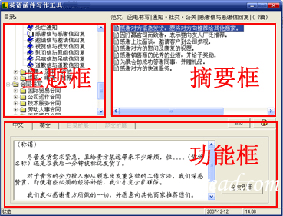国务院办公厅转发信息产业部、国家广播电影电视总局关于加强广播
|
(Issued by Document Guobanfa No. 82 [1999] of the General Office of the State Council on September 17, 1999) The Opinions on Strengthening Construction and Management of Radio and Television Cable Networks submitted by the Ministry of Information Industry and the State Administration of Radio, Film and Television have been agreed by the State Council and are hereby transmitted to you for your implementation accordingly. Appendix: Opinions on Strengthening Construction and Management of Radio and Television Cable Networks (submitted by the Ministry of Information Industry and the State Administration of Radio, Film and Television on September 13, 1999) The radio and television transmission network in China has seen nearly 50 years' history of development. The radio network was initially developed dated back to the beginning of the foundation of the Republic. In the early 80s, the cable television began to develop. In the 90s, the construction of radio and television networks came to a stage of high-speed development, and the completed cable television transmission networks now extend up to 2.25 million kilometers. Since 1992, the number of new subscribers to cable television networks expands at a speed of 10 million per year, and the number of subscribers to cable television networks across the country has reached 77 million as of December 1998 ranking No. 1 in the world. Radio and television and the transmission networks thereof have become an important part of the drive toward information of the country. In order to guarantee the safe broadcasting of radio and television programs and avoid repetitive construction of cable transmission networks, the following opinions on strengthening construction and management of radio and television cable networks are formulated: I. Preventing Repetitive Construction Firmly It is imperative to firmly implement the relevant provisions of the Circular of the General Office of the State Council on Strengthening Construction and Management of Radio and Television Cable Networks (Guobanhan No. 33 [1998]) and other regulations, formulate specific and far more operative measures in light of the actual condition of the radio and television departments, and promptly fulfil the requirements such as implementing the separation of policy-making from enterprise management in the construction and management of radio and television transmission networks, establishing radio and television transmission companies in form of enterprise to accept overall planning and industrial management from the competent department of information industry and firmly preventing repetitive construction. In accordance with the spirit of directives from leaders of the State Council on making good use of existing communication networks and the radio and television departments being permitted to install cable television end-user networks, the construction of radio and television cable networks shall be handled in light of the conditions of two categories. One category is the radio and television transmission fiber trunk lines from the central to the county levels, and those which have not yet been constructed by the radio and television departments shall be no longer constructed in principle. It is imperative to make full use of the State communication backbone network and other completed networks by any means and cease repetitive construction. Any new construction project needed really shall meet the State planning toward information and be subject to approval by the competent department of information industry. Another category is the radio and television distribution networks below the level of an urban district or a county, that is, the network from the broadcasting front of a city or county radio or television station to users, which shall be built into relatively complete special-purpose networks by the radio and television departments to meet special requirements for management of radio and television programs and expansion of users. Any new construction project for the upper part from the user point in a distribution network shall be subject to overall planning and approval by the competent department of information industry; the user part of the distribution network shall be developed by a radio station or television station according to the need to expand users. II. Ensuring Safe Transmission of Radio and Television Programs With the development of science and technology, radio and television have become the most popular transmission media by their own technical advantages, and are the important battlefields for giving public opinions and doing publicity. This particularity shall be considered adequately in the management of radio and television transmission networks. Meanwhile, for the further opening up of our country to the outside world, how to ensure the safe transmission of radio and television programs shall also be considered. Therefore, in spite of the provisions for establishment of radio and television network transmission companies and the acceptance of industrial management by the competent department of information industry in making overall planning and national technical standards and other aspects of radio and television transmission networks, to provide necessary conditions for the effective and good management of radio and television publicity, it is necessary to reiterate that permission shall be obtained from the competent department of radio and television for creating cable television channels, setting up on-line broadcasting fronts, engaging in radio and television program transmission businesses and etc. III. Accelerating the Reform in the Radio and Television Industry (1) Establishing radio and television network transmission companies in form of enterprise. In accordance with the reform in the radio and television industry and the spirit of the central authorities regarding rectification of loose and excessive status, on the basis of existing assets of radio and television networks, companies shall be formed within each province, autonomous region and municipality directly under the Central Government and branches or subsidiaries thereof shall be established correspondingly at prefectures (municipalities) and counties, engaging in operation and management of radio and television transmission businesses in a centralized way. The issue on assets restructuring for State fiber trunk lines having been established by the State Administration of Radio, Film and Television shall be researched as a special subject, and a disposition plan shall be proposed. There may be two ways to form a radio and television network transmission company: the one is, on the basis of the formation of a radio and television group comprising radio and television stations in a province, an autonomous region or a municipality directly under the Central Government, a network transmission company shall be incorporated into the group; the other is, transmission network assets having been already formed by the radio and television departments at all levels shall be incorporated into the radio station and television station at the same level, and then such stations shall form a radio and television network transmission company. Network transmission companies shall, in accordance with relevant State regulations, guarantee the safe transmission of radio and television programs, and meanwhile conduct appropriately the cooperation relationship with telecommunication and other areas. Before relevant regulations are formulated, radio and television network transmission companies will not be listed for the time being, and if need be, the cases shall be individually reported for examination and approval. Radio stations, television stations and their broadcasting business, program making and advertisement business shall not be listed. (2) Encouraging public channels vigorously. On the basis of three stations into one as practiced in radio and television stations at the county level, the provincial television station shall make a set of public programs to be broadcast by county stations under its jurisdiction, and have its certain period of time available to county stations for broadcasting their own made news and special programs. Merger of municipal (prefectural) and provincial wireless television stations and cable television stations shall be promoted, reasonable allocation of resources shall be further optimized, and internal conflicts shall be further reduced. IV. Reducing the Network Rent by a Big Margin At present, the fee for leasing telecommunication networks is too high, and accordingly, leasing a network costs much than constructing a network. To change this condition, a reasonable price shall be determined as soon as possible, and the rent shall be reduced to such a level that the unit network user prefers leasing a network to constructing a network, avoiding repetitive construction by a mechanism. V. Continuing the Separation of Businesses between the Telecommunication Department and the Radio and Television Department It is provided that the telecommunication department is prohibited from engaging in the radio and television business and the radio and television department is prohibited from engaging in the communication business, and this provision shall be firmly enforced and executed. Consolidated use of various network resources is temporarily in trial only in Shanghai. |








